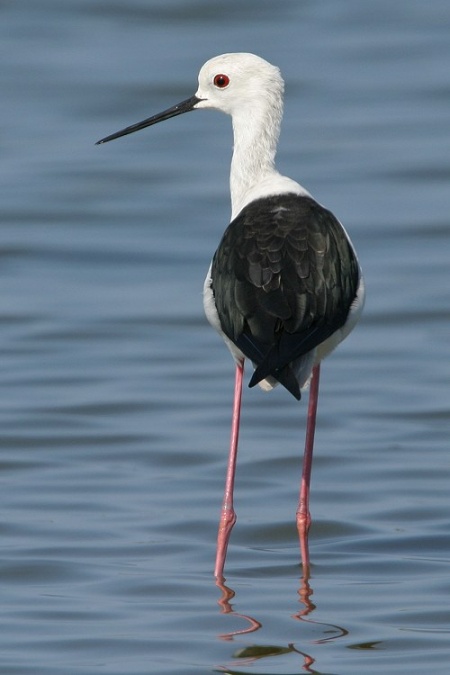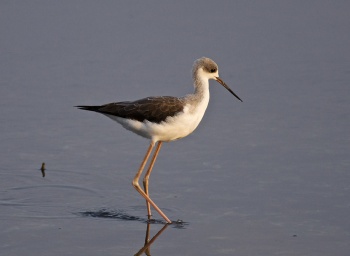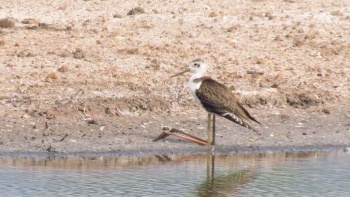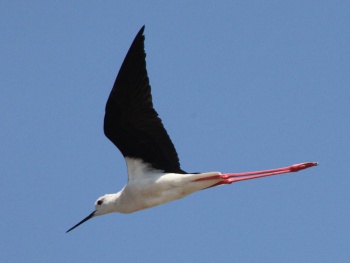(References updated) |
Aloktewari (talk | contribs) (Image of young chick) |
||
| (9 intermediate revisions by 3 users not shown) | |||
| Line 1: | Line 1: | ||
'''Disambiguation: The [[Australia|Australian]] species of [[White-headed Stilt]] (or Pied Stilt) is also known as Black-winged Stilt''' | '''Disambiguation: The [[Australia|Australian]] species of [[White-headed Stilt]] (or Pied Stilt) is also known as Black-winged Stilt''' | ||
| + | [[Image:Black-winged_Stilt.jpg|thumb|450px|right|"Sammy"<br />Photo by {{user|nigelblake|Nigel Blake}}<br />[[Titchwell Marsh|Titchwell]], [[Norfolk]], August 2004]] | ||
;[[:Category:Himantopus|Himantopus]] himantopus | ;[[:Category:Himantopus|Himantopus]] himantopus | ||
| − | |||
==Identification== | ==Identification== | ||
| − | 33-36 cm | + | 33-36 cm (13-14¼ in)<br /> |
| + | *Black upperparts | ||
| + | *White underparts | ||
| + | *White head and neck | ||
| + | *Long pink legs | ||
| + | *Long thin black bill<br /> | ||
'''Male''' - black back with green gloss<br /> | '''Male''' - black back with green gloss<br /> | ||
'''Female''' - brown back. <br /> | '''Female''' - brown back. <br /> | ||
| Line 11: | Line 16: | ||
====European population==== | ====European population==== | ||
Breeds irregularly in scattered localities in southern [[Europe]] but an opportunistic species that occasionally breeds far out of normal range or abandons long-established areas for no apparent reason. May not breed at all in dry years. Most regular areas are Iberia and western and southern [[France]], [[Sardinia]], [[Sicily]] and [[Italy]], [[Cyprus]], [[Greece]], [[Romania]], [[Bulgaria]] and [[Turkey]], the [[Ukraine]] and southern [[Russia]], and in Mesopotamia. Also breeds on the Mediterranean coast of North [[Africa]], in parts of the [[Middle East]] and on the [[Cape Verde Islands]]. Has bred in [[Britain]], northern [[France]], [[Belgium]], the [[Netherlands]], [[Austria]], [[Germany]] and [[Poland]], also in the [[Canary Islands]]. | Breeds irregularly in scattered localities in southern [[Europe]] but an opportunistic species that occasionally breeds far out of normal range or abandons long-established areas for no apparent reason. May not breed at all in dry years. Most regular areas are Iberia and western and southern [[France]], [[Sardinia]], [[Sicily]] and [[Italy]], [[Cyprus]], [[Greece]], [[Romania]], [[Bulgaria]] and [[Turkey]], the [[Ukraine]] and southern [[Russia]], and in Mesopotamia. Also breeds on the Mediterranean coast of North [[Africa]], in parts of the [[Middle East]] and on the [[Cape Verde Islands]]. Has bred in [[Britain]], northern [[France]], [[Belgium]], the [[Netherlands]], [[Austria]], [[Germany]] and [[Poland]], also in the [[Canary Islands]]. | ||
| + | [[Image:Black-winged stilt 5.jpg|thumb|350px|right|Juvenile<br />Photo by {{user|riccardo.rondinone|riccardo.rondinone}}<br />Stagni della Marza, [[Sicily]], August 2009]] | ||
| + | Most birds are migratory especially in the north but frequently winters in southern Europe and occasionally further north, and regularly in North [[Africa]] and [[Iraq]]. | ||
| − | |||
| − | |||
=====Vagrancy in Europe===== | =====Vagrancy in Europe===== | ||
Vagrant to most European countries north to [[Sweden]], [[Finland]] and [[Estonia]]. Also recorded on the [[Azores]], [[Madeira]] and [[Canary Islands]]. In [[Britain]] several are now recorded annually and breeding has been attempted at least six times. Most of the c.300 records have occurred in the south-east and in April-May and August-September. | Vagrant to most European countries north to [[Sweden]], [[Finland]] and [[Estonia]]. Also recorded on the [[Azores]], [[Madeira]] and [[Canary Islands]]. In [[Britain]] several are now recorded annually and breeding has been attempted at least six times. Most of the c.300 records have occurred in the south-east and in April-May and August-September. | ||
A male (nicknamed "Sammy") at [[Titchwell Marsh|Titchwell]] in [[Norfolk]], [[England]], was still present in August 2004 after becoming resident in the area in September 1993. | A male (nicknamed "Sammy") at [[Titchwell Marsh|Titchwell]] in [[Norfolk]], [[England]], was still present in August 2004 after becoming resident in the area in September 1993. | ||
| − | |||
Accidental to the [[Aleutians]] in [[Alaska]]. | Accidental to the [[Aleutians]] in [[Alaska]]. | ||
==Taxonomy== | ==Taxonomy== | ||
| − | This is a [[Dictionary_M- | + | [[Image:black-winged_stilt_alok_2.JPG|thumb|350px|right|Young independent chick<br />Photo by {{user|aloktewari|Alok Tewari}}<br />[[Keoladeo National Park]], Bharatpur, [[India]], June-2017]] |
| + | This is a [[Dictionary_M-O#M|monotypic]] species<sup>[[#References|[1]]]</sup>. | ||
[[White-headed Stilt]] (or Pied Stilt) of [[Australia]], has been split from this species<sup>[[#References|[2]]]</sup>. | [[White-headed Stilt]] (or Pied Stilt) of [[Australia]], has been split from this species<sup>[[#References|[2]]]</sup>. | ||
| + | |||
==Habitat== | ==Habitat== | ||
Areas of shallow water, fresh or brackish, with margins of sand or mud, but does not require vegetation to any extent. Usually on lagoons or in estuarine or delta areas. | Areas of shallow water, fresh or brackish, with margins of sand or mud, but does not require vegetation to any extent. Usually on lagoons or in estuarine or delta areas. | ||
| − | + | ||
==Behaviour== | ==Behaviour== | ||
Often loosely colonial when breeding. | Often loosely colonial when breeding. | ||
====Vocalisation==== | ====Vocalisation==== | ||
| + | [[Image:IMG 53972.JPG|thumb|350px|right|Juvenile 'resting'<br />Photo by {{user|Scridifer|Scridifer}}<br />Povelianovo, [[Bulgaria]], July 2016]] | ||
<flashmp3>Himantopus himantopus (song).mp3</flashmp3><br /> | <flashmp3>Himantopus himantopus (song).mp3</flashmp3><br /> | ||
| − | ''[[Media:Himantopus himantopus (song).mp3|Listen in an external program]]'' | + | ''[[Media:Himantopus himantopus (song).mp3|Listen in an external program]]''<br /> |
| + | <flashmp3>black-winged_stilt_alok.mp3</flashmp3><br /> | ||
| + | ''[[Media: black-winged_stilt_alok.mp3|Listen in an external program]]''<br /> | ||
| + | Recording by {{user|aloktewari|Alok Tewari}}<br /> | ||
| + | Jamnagar, Gujarat, [[India]], Jan-2016<br /> | ||
| + | Call given by a group circling over a pond; consisting of 10-12 birds. | ||
==References== | ==References== | ||
| − | #{{Ref- | + | |
| + | [[Image:Polojnik 8768.jpg|thumb|350px|right|<br />Photo by {{user|mikemik|mikemik}}<br />Seceoveljske soline, [[Slovenia]], June 2009]] | ||
| + | #{{Ref-Clements6thAug16}}#Avibase | ||
{{ref}} | {{ref}} | ||
==External Links== | ==External Links== | ||
{{GSearch|Himantopus_himantopus}} | {{GSearch|Himantopus_himantopus}} | ||
<br /> | <br /> | ||
| − | {{Video| | + | {{Video|Black_winged_Stilt}} |
[[Category:Birds]][[Category:Himantopus]] [[Category:Bird Songs]][[Category:Videos]] | [[Category:Birds]][[Category:Himantopus]] [[Category:Bird Songs]][[Category:Videos]] | ||
Revision as of 09:09, 30 June 2017
Disambiguation: The Australian species of White-headed Stilt (or Pied Stilt) is also known as Black-winged Stilt
- Himantopus himantopus
Identification
33-36 cm (13-14¼ in)
- Black upperparts
- White underparts
- White head and neck
- Long pink legs
- Long thin black bill
Male - black back with green gloss
Female - brown back.
Immature - grey, sandy wings.
Distribution
Europe, Mediterranean and sub-Saharan Africa to Southeast Asia and Taiwan.
European population
Breeds irregularly in scattered localities in southern Europe but an opportunistic species that occasionally breeds far out of normal range or abandons long-established areas for no apparent reason. May not breed at all in dry years. Most regular areas are Iberia and western and southern France, Sardinia, Sicily and Italy, Cyprus, Greece, Romania, Bulgaria and Turkey, the Ukraine and southern Russia, and in Mesopotamia. Also breeds on the Mediterranean coast of North Africa, in parts of the Middle East and on the Cape Verde Islands. Has bred in Britain, northern France, Belgium, the Netherlands, Austria, Germany and Poland, also in the Canary Islands.
Most birds are migratory especially in the north but frequently winters in southern Europe and occasionally further north, and regularly in North Africa and Iraq.
Vagrancy in Europe
Vagrant to most European countries north to Sweden, Finland and Estonia. Also recorded on the Azores, Madeira and Canary Islands. In Britain several are now recorded annually and breeding has been attempted at least six times. Most of the c.300 records have occurred in the south-east and in April-May and August-September.
A male (nicknamed "Sammy") at Titchwell in Norfolk, England, was still present in August 2004 after becoming resident in the area in September 1993. Accidental to the Aleutians in Alaska.
Taxonomy
This is a monotypic species[1].
White-headed Stilt (or Pied Stilt) of Australia, has been split from this species[2].
Habitat
Areas of shallow water, fresh or brackish, with margins of sand or mud, but does not require vegetation to any extent. Usually on lagoons or in estuarine or delta areas.
Behaviour
Often loosely colonial when breeding.
Vocalisation
<flashmp3>Himantopus himantopus (song).mp3</flashmp3>
Listen in an external program
<flashmp3>black-winged_stilt_alok.mp3</flashmp3>
Listen in an external program
Recording by Alok Tewari
Jamnagar, Gujarat, India, Jan-2016
Call given by a group circling over a pond; consisting of 10-12 birds.
References
- Clements, J. F., T. S. Schulenberg, M. J. Iliff, D. Roberson, T. A. Fredericks, B. L. Sullivan, and C. L. Wood. 2016. The eBird/Clements checklist of birds of the world: v2016, with updates to August 2016. Downloaded from http://www.birds.cornell.edu/clementschecklist/download/
- Avibase
Recommended Citation
- BirdForum Opus contributors. (2024) Black-winged Stilt. In: BirdForum, the forum for wild birds and birding. Retrieved 19 April 2024 from https://www.birdforum.net/opus/Black-winged_Stilt
External Links








